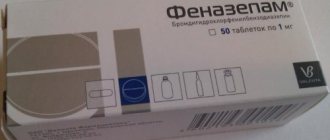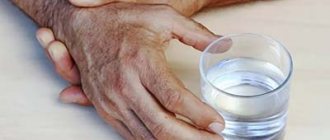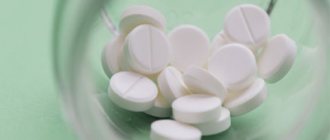Indications and contraindications for treatment with Phenazepam
Instructions for use indicate various pathological conditions for which the drug is effective:
- for neuroses, psychopathy, accompanied by sudden changes in mood, anxiety, irritation, fear, tension;
- reactive psychoses, sleep disorders;
- hypochondria, autonomic dysfunction syndrome;
- epilepsy, panic attacks, dyskinesias, nervous tics;
- to prevent phobias and similar conditions;
- with increased muscle tone and rigidity;
- lability of the autonomic nervous system;
- alcohol withdrawal.
The drug is used in preliminary preparation before surgery and general anesthesia.
Phenazepam is included in the list of potent medications, has many contraindications for use and is changed for certain categories of patients. The drug is not prescribed to patients:
- in coma or shock;
- with myasthenia gravis, angle-closure glaucoma - in case of an acute attack or hereditary predisposition;
- with COPD, acute respiratory failure;
- minors, pregnant and lactating women;
- with individual intolerance to the component composition.
Supervision by a specialist during therapy is necessary for patients with renal or hepatic dysfunction. Increased caution is required when treating people with drug addiction syndrome, psychological dependence on medications, and in old age.
Phenazepam
The medicine copes well with seizures, promotes relaxation, and has a hypnotic effect.
Now doctors use this medicine to treat panic attacks, epilepsy, insomnia, depression, anxiety, and alcohol withdrawal. The drug can cause a feeling of drowsiness, a surge of strength, positive emotions, however, it can cause attacks of irritability and anger. Phenazepam is addictive. Its use is possible only after a doctor has prescribed it, who will take into account all the risks and accurately determine the dose. Side effects of the drug include decreased blood pressure and weight, tachycardia, problems with salivation and gastrointestinal tract (vomiting, diarrhea, heartburn); malfunctions of the hematopoietic system; a sore throat; kidney dysfunction; decreased sexual function.
Abuse of the drug is fraught with the appearance of convulsions, fever, and coma. With prolonged use, addiction to the drug occurs, and subsequently disorders of the nervous system are possible. Over time, with constant use, the feeling of euphoria is replaced by constant irritability, sleep deteriorates, and the person begins to be haunted by nightmares and thoughts of suicide. In the UK, phenazepam is considered a powerful narcotic. The effect of phenazepam on the human body is difficult to predict, so drug addicts most often use it to ease withdrawal symptoms and the process of falling asleep.
When using sleeping pills for medicinal purposes, it is strictly forbidden to mix it with alcoholic drinks - this leads to complete inappropriate behavior. A person can remain in this state for several days. Discontinuation of the drug should also be carried out by a specialist. You cannot stop taking phenazepam suddenly and immediately; withdrawal should be gradual.
Phenazepam is considered a drug for providing quick relief, but it cannot cure the disease. So it is mainly used as an aid. It is often prescribed after a stroke to reduce agitation and anxiety. The use of phenazepam should last no more than 10 days. With longer use, the appearance of withdrawal syndrome must be taken into account.
In our country, the drug is not classified as a narcotic drug and is used in the potent category. But long-term uncontrolled use leads to toxic effects on the brain and changes in thinking. Taking phenazepam imposes certain restrictions and forces you to limit your activities.
The drug belongs to the group of benzodiazepine tranquilizers and is addictive very quickly. Similar drugs with different dosages of phenazepam are diazepam, sibazon, tazepam, bromazepam. Phenazepam is usually prescribed in a dosage of 3 to 5 milligrams per day. If the dose is exceeded, the drug can have unexpected effects, causing headaches and attacks of aggression. However, proper use of the drug is quite effective.
Phenazepam
reviews can be a life-saving medicine, but only under the strict supervision of a doctor. It is prescribed strictly individually, based on the client’s testimony. Withdrawal of the drug should be carried out as smoothly as its introduction. If you want to overcome an illness, do not self-medicate - contact a specialist.
Doctors from the Center for Neurology and Sleep Medicine will help you prescribe effective sleeping pills and cure insomnia.
Return to list
Adverse reactions during therapy with Phenazepam
Non-standard reactions of the body arise against the background of the above contraindications or as an individual reaction of the body. The problem is related to the influence of the components on the functionality of the nervous system.
The majority of those undergoing the procedure experience increased drowsiness, chronic fatigue, lethargy, and attacks of dizziness. Patients complain of impaired concentration, problems with orientation in space, symptoms of ataxia, confusion, and slow psychomotor reactions.
A list of rarer side effects from Phenazepam is presented:
- cephalgia, euphoria;
- depression, tremor;
- problems with memory, coordination of movements;
- asthenia, myasthenia, dysarthria.
Occasionally, therapeutic manipulations provoke attacks of aggression, phobias, and hallucinations. Patients develop suicidal tendencies, insomnia, and muscle spasticity.
When the digestive tract is damaged, the following occurs:
- dryness of the oral mucosa;
- involuntary secretion of saliva;
- refusal to eat, constipation with diarrhea;
- heartburn, nausea, yellowing of the skin;
- increased activity of liver enzymes.
Therapy with Phenazepam can cause increased or decreased sexual desire and symptoms of dysmenorrhea. Some patients experience allergies with skin rashes and obsessive itching. A list of other adverse reactions is presented:
- addiction and development of drug dependence;
- drop in blood pressure level;
- impaired vision clarity with doubling of objects;
- weight loss, heart rhythm disturbances.
With a sharp reduction in dosage or stopping treatment, withdrawal syndrome occurs. Clinical signs of the pathology resemble the symptoms that led to the need for Phenazepam procedures.
Phenazepam in narcology
Phenazepam in the form of tablets
Phenazepam is a common drug, including in addiction medicine. It is used for neurological problems; phenazepam is used to treat:
- neuroses,
- anxiety states,
- insomnia,
- phobias.
Phenazepam is also used for hangovers to relieve withdrawal symptoms.
Like all benzodiazepine tranquilizers, phenazepam restores the central nervous system and normalizes its functioning. It is necessary to take phenazepam with a hangover with caution and only under the supervision of a doctor.
Dosages and methods of taking the drug from the instructions
The daily dosage of the drug is 1.5-5 mg. It is divided into 2-3 doses. In the morning, 0.5-1 mg of Phenazepam is used, in the evening the dose is increased to 2.5 mg. The daily volume should not exceed 10 mg.
The course of therapy depends on the current pathological process:
- sleep disorders - 0.25-0.5 mg half an hour before night rest;
- neuroses, psychopathy - procedures begin with 1.5-3 mg (divided into three doses), after 2-4 days - 4-6 mg;
- motor restlessness, fear, anxiety – 3 mg each, the volume is increased depending on the tolerability of the medication and to achieve the expected clinical effect;
- epileptic seizures – 2-10 mg;
- alcohol withdrawal – 2.5-5 mg;
- increased muscle tone – 2-6 mg.
To prevent addiction and the development of dependence on the drug, Phenazepam is prescribed in two-week courses. In difficult cases, therapy is extended to 2 months; discontinuation of the drug requires a gradual reduction in the initial dosage.
Use after binge drinking
Among the indications for the use of Phenazepam is withdrawal syndrome, which is accompanied by the following symptoms:
- state of heightened anxiety and fear
- sleep disorders
- state of psychosis
- emotional lability
- increased irritability
In the first day after the end of the binge, tablets are used with great caution. Ethanol is still present in the blood, so the mental reaction to the administration of the drug can be unpredictable. Patients with alcoholism who took Phenazepam simultaneously with alcohol noted the appearance of hallucinations, memory impairment, aggressiveness or suicide attempts. The risk of suicidality increases with existing depressive disorders.
Phenazepam is taken under the supervision of a physician. The daily dose should not exceed 5 mg, it is divided into 2 doses. Increasing the dose for a person suffering from alcohol dependence increases the likelihood of addiction to the drug.
When using the drug on the first day of withdrawal, there is a risk of severe complications during sleep. Phenazepam depresses breathing, and in a person with chronic alcoholism, this process is enhanced due to the toxic effect of ethanol on the brain. Therefore, during sleep, breathing may stop and heart function may be disrupted.
Sleep when using Phenazepam is deep, and the gag reflex in this state may not lead to awakening. In this case, the person will choke or there will be long-term consequences of vomit entering the pulmonary system - bronchiolitis.
Treatment of withdrawal syndrome is carried out comprehensively, the duration of taking the drug is on average 2 weeks. After completing the course, you should not suddenly stop taking Phenazepam; this will cause severe withdrawal symptoms. Therefore, the dosage is reduced gradually over 1-2 weeks.
Rules for taking phenazepam for withdrawal symptoms
Indications for the use of phenazepam include alcohol withdrawal syndrome. The course of treatment can be quite long. Phenazepam is taken from several weeks to several months.
Phenazepam should never be taken with alcohol, as this will lead to the opposite result and increase the withdrawal syndrome.
When treating withdrawal symptoms in alcoholism, phenazepam is prescribed 1-2 tablets per day, up to a total of 5 mg. The daily dose of phenazepam is divided into 2-3 doses. In neurology, the maximum daily dose of phenazepam reaches 10 mg in the treatment of diseases with muscle hypertonicity.
Typically, treatment with phenazepam is prescribed for up to two weeks, and then the dosage is gradually reduced to avoid withdrawal symptoms. Phenazepam itself can cause addiction and withdrawal symptoms, so you need to take it carefully.
Withdrawal syndrome in alcoholism
The cause of binge drinking is alcohol withdrawal syndrome. This is a complex of pathologies and dysfunctions that appear in an alcoholic when he gives up alcohol. Withdrawal syndrome is not the same as a regular hangover. Such a phenomenon as withdrawal syndrome appears only in the second stage of the disease and continues in the third. This is a number of psychological, somatic, neurological and autonomic disorders:
- Strong headache.
- Gastrointestinal disorders.
- Violations of the body's thermoregulation, chills.
- Cardiac dysfunction, rapid heartbeat, tachycardia.
- Tremor of the limbs.
- Depressed mood, depression.
- Strong desire to drink alcohol.
- Uncoordination of movements.
- Increased sweating.
- Sleep disturbances, insomnia.
Usually the patient is unable to endure these painful symptoms, so he drinks alcohol. That is why withdrawal syndrome requires treatment with medications, otherwise the patient faces binge drinking.










